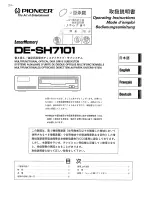
Positioning and Optimizing
Dynaudio Sub 300/500
19
Multi-channel
bass-management system
Many multi-channel processors and receivers provide elaborate bass-management
systems where the cross-over frequency for both subwoofer and main speakers can
be set. If you are using such a bass-management system, you can select the
Flat
setting on the subwoofer's remote control, as all filtering has been done by the bass-
management system. Carefully follow the instructions for the amplifier/processor or
receiver.
Note
•
If you are using your system's bass-management system, ensure that the
subwoofer's cross-over frequency hasn't been set to the same or lower frequency
compared to the setting chosen with the bass management system.
•
Selecting the correct frequency depends to a large extend on the main speakers.
Sometimes main speakers are specifically intended to work with a subwoofer. In
such cases, the main speakers can get damaged by a full-range amplifier signal. If
in doubt, check the operating guide for the main speakers for any restrictions or
recommendations.
Loudspeakers
with full-range signal
Of course it is possible to combine the subwoofer in a system where the loudspeakers
are being fed with a full-range signal. In that case, setting the cross-over frequency
for the subwoofer depends very much on the natural roll-off frequency in the bass of
the main speakers. In general, a large, floor-standing speaker will still have significant
output in the deeper bass range, in which case the cross-over frequency should be
set to 60 Hz. A small or very small speaker will have less deep bass output in which
case the setting should be 80 Hz or 100 Hz. To find the correct setting in such
scenarios:
X
Play a music track that has a significant amount of bass over a large bass region.
An instrument such as a double-bass or bass-guitar is very suitable. Starting with
the 60 Hz position, use this track to set the subwoofer's relative volume level.
X
Listen carefully to the bass-line played by the instrument. As it goes up and down
in the bass range, the overall bass volume should remain the same, be it with very
deep or higher bass notes. Particularly with very small main speakers, it may be
that you can hear a “hole” in the bass response: You can hear the deepest bass
notes and everything from lower midrange easily, but overall the bass leaves a thin
impression. On the other hand, it may be that using the 60 Hz setting the system
already sounds good. In both cases, select the next setting, 80 Hz.
X
Playing the same track at the same volume level, again listen to the overall bass
volume level. Should the bass volume suddenly become louder or bloated at
certain tones compared to the 60 Hz setting earlier, revert to this setting; in this
case setting the cross-over frequency is done. If the apparent hole in bass
response is still present or if the system sounds good now, move on to the next
setting, 100 Hz.
X
Again play the track to listen to the overall bass volume level. Should the bass
volume suddenly become louder or bloated at certain tones compared to the 80 Hz
setting earlier, revert to this setting. If the bass sounds correct now, leave the
setting at 100 Hz.
Sub300_500_en.book Page 19 Dienstag, Mai 11, 2010 5:02 PM








































